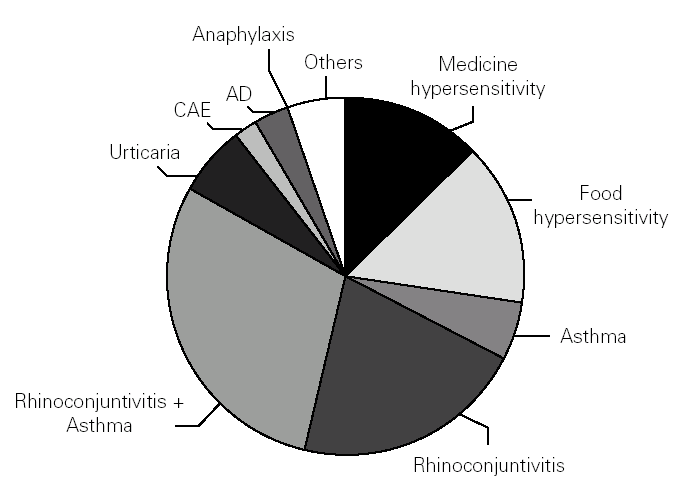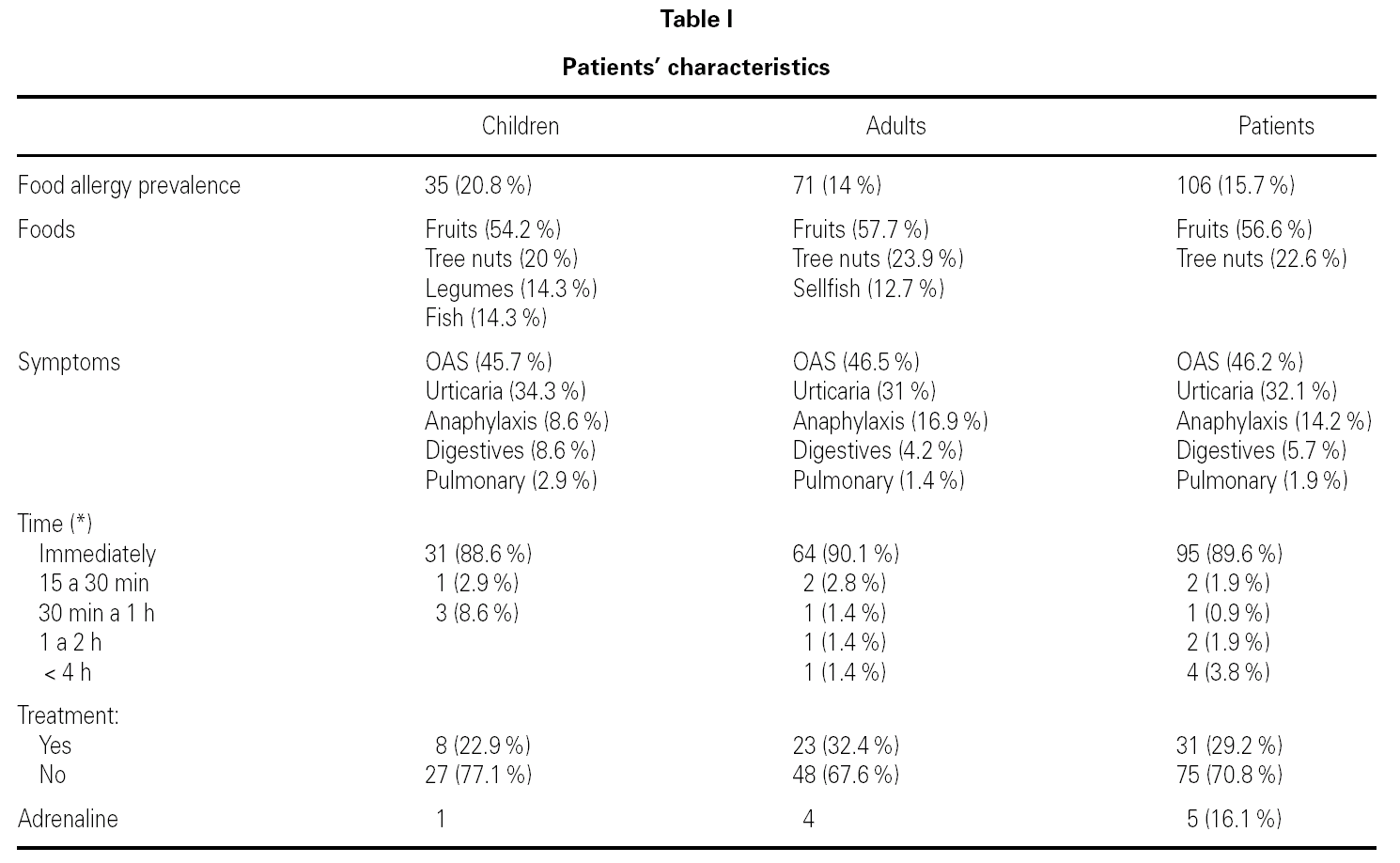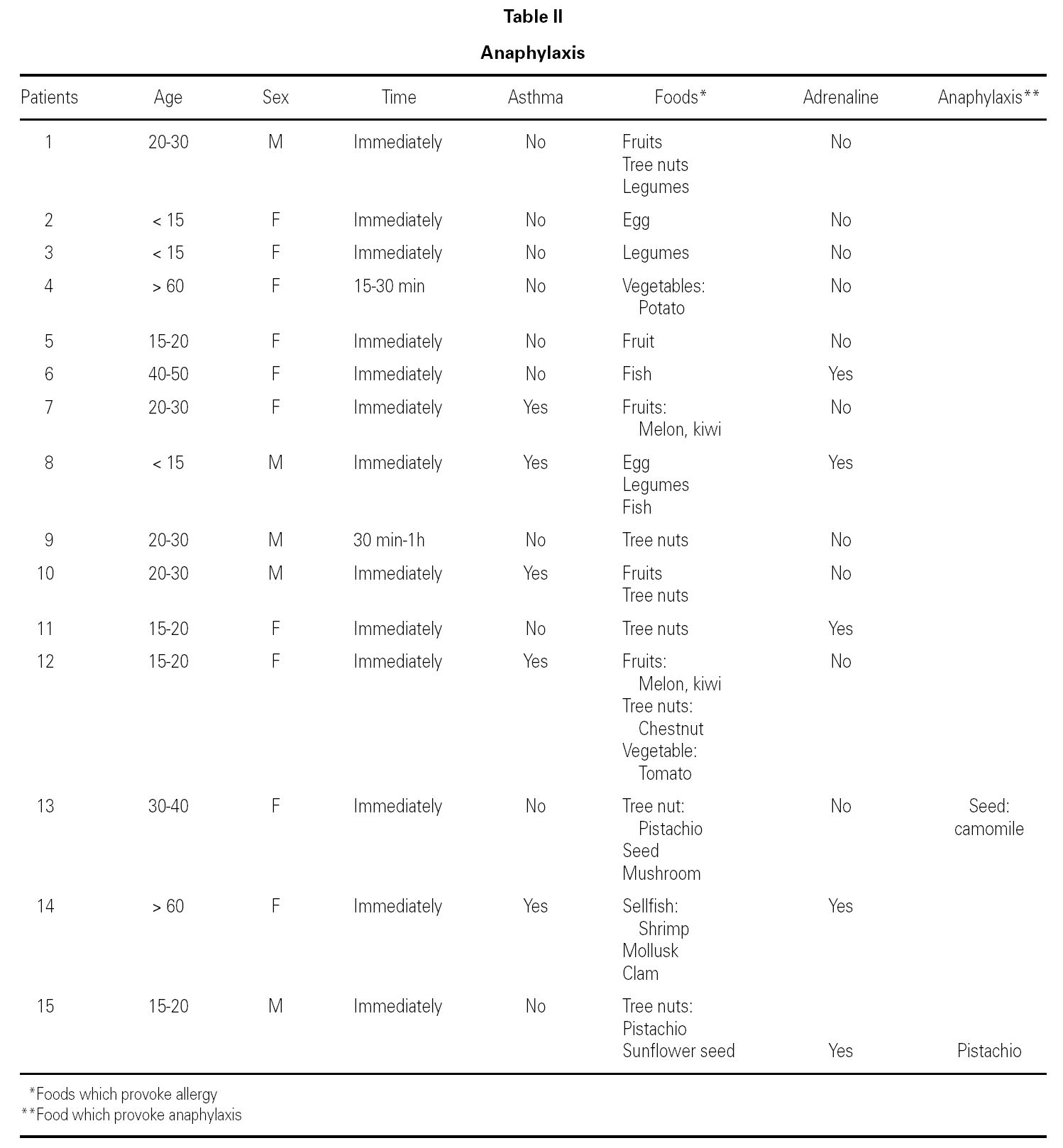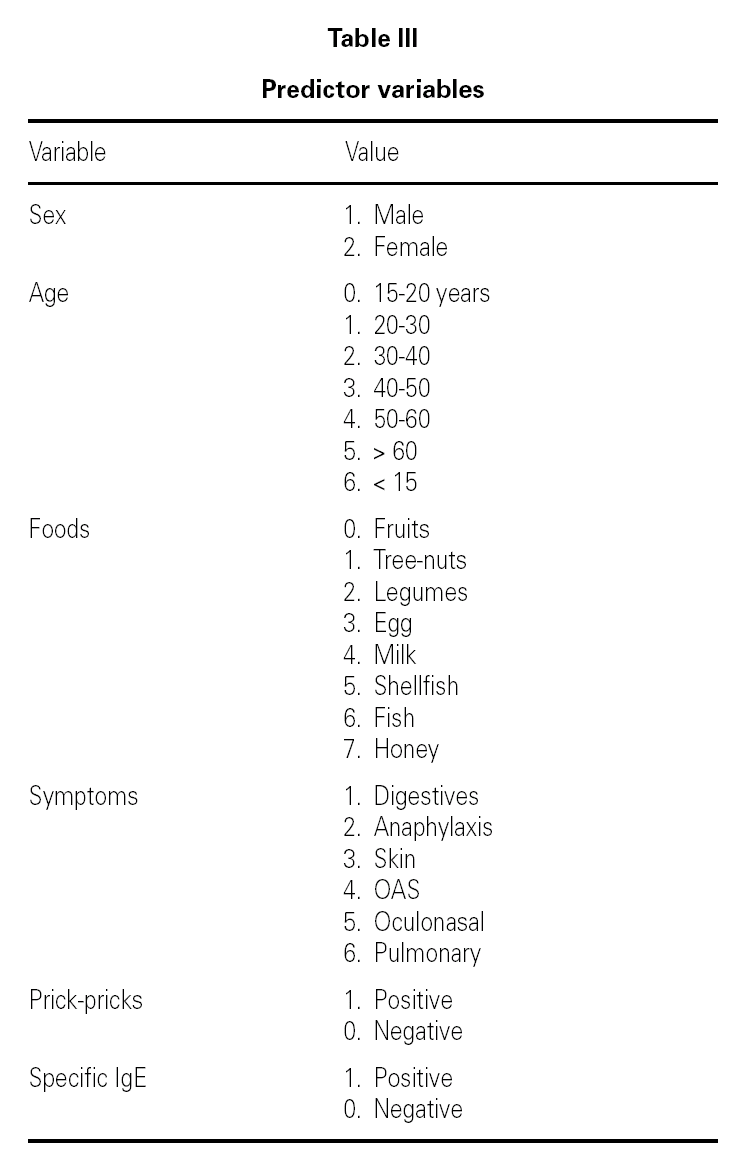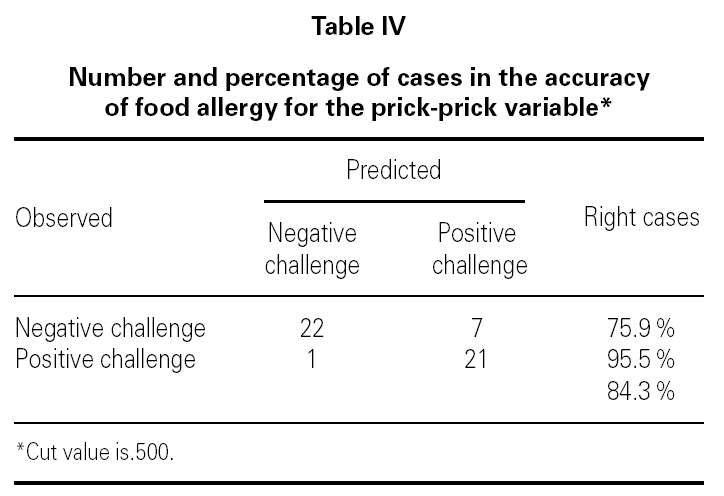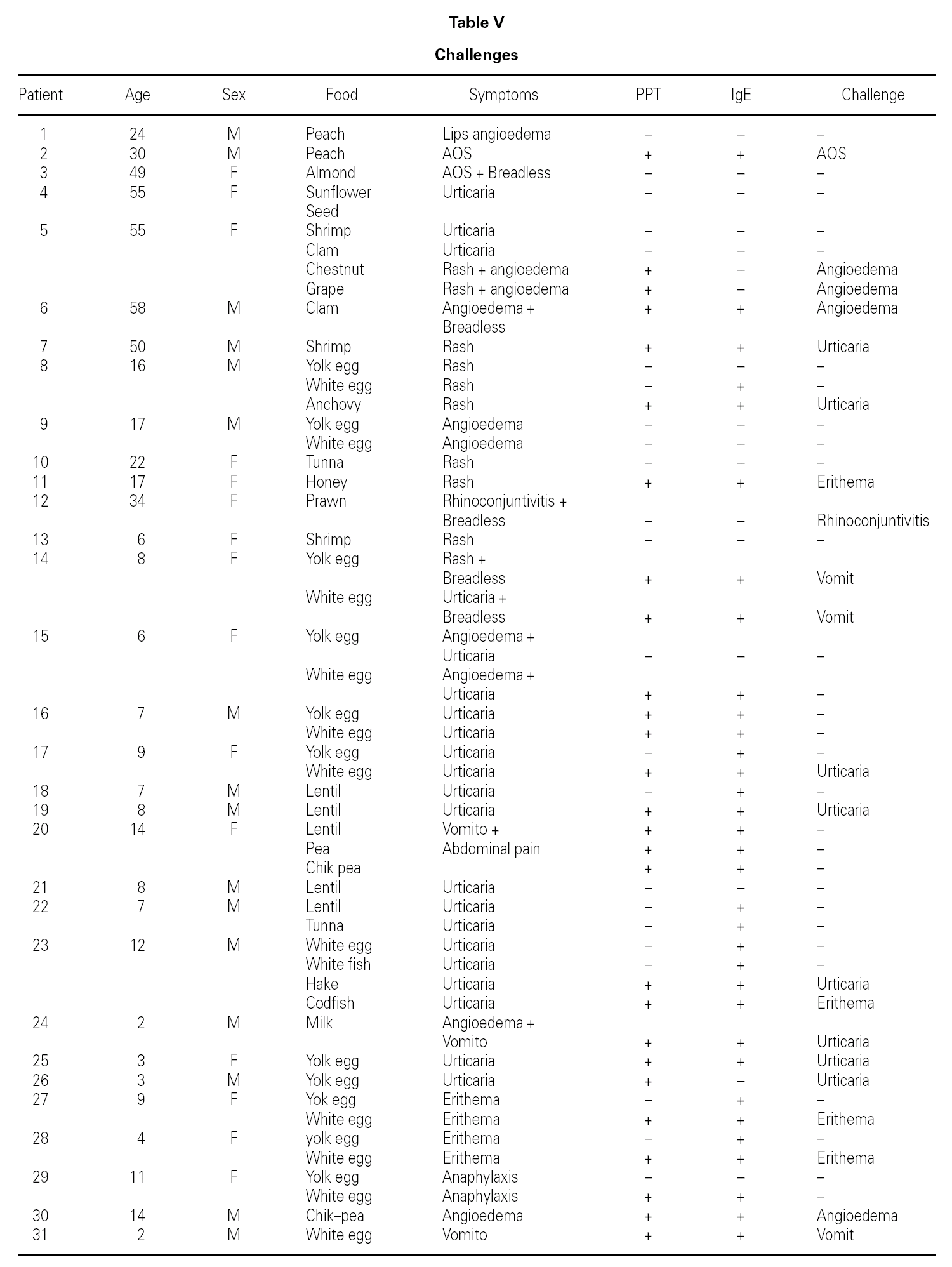The European Academy of Allergy and Clinical Immunology (EAACI) defines the hypersensitivity food reactions according to the mechanisms which produce them. The food allergy is a disorder in which a little quantity of food induces an immunological reaction. Foods can provoke allergic reactions through several mechanisms. The most important and the one that has undergone more studies is the IgE mediated reaction type I since it can be life threatening. However, there are different immunological non-IgE mediated mechanisms such as the type IV retarded reactions. The food hypersensitivity reactions non-mediated immunologically (what used to be known as intolerance reactions) may be due to pharmacology, metabolic and toxic causes 1.
There isn't patgnomonic clinical of food allergies. The most rateable element in the anamnesis is that the relation is close in time. The more frequent symptoms are urticaria and angioedema. Both, acute rhinitis and rhinorrea whether accompanied by conjunctivitis or not are often observed in challenges. It is estimated that foods provoke a third of the anaphylactic shocks
Nowadays, the incidence and prevalence of allergic diseases is on the increase in industrial countries, specially those food allergies which present a high mortality rate and are life threatening. This is related to the deterioration of life-quality and to an increase in social and sanitary costs, and also to work and school absenteeism.
The usual diagnostic instruments are satisfactory only for class 1 food allergy in which the sensitization process occurs in the gastrointestinal tract. This kind of food allergy is rare in adults and one of the first manifestations in children. Class 2 food allergy is mainly seen in adults and develops as a consequence of an allergic sensitization to inhalant allergens, the majority of these proteins are difficult to extract and highly labile. Therefore, diagnostic setups using natural extracts for in vivo and in vitro assays are in many cases unsatisfactory 2. The lack of reliable extracts makes us carry out challenges with the consequent waste of time and the possible risk for the patient undergoing the test. The challenge procedure is difficult to carry out since the food should be fresh and be taken immediately in the case of SAO. Nowadays the challenge procedures are not standardised and that is why it isn't possible to compare the results between different centres and different populations. There are no direct comparative studies in scientific protocols available in the literature that directly compares the various parameters: timing between two subsequent challenges or increment of the dose for the challenge. Moreover, these tests cannot be performed on all the individuals, there are certain types of patients who require standardized programmes and those tests must be adjusted according to the nature and severity of the reaction: atopic eczema dermatitis syndrome, patients with controversial symptoms often of subjective nature such as chronic fatigue syndrome, chronic urticaria, patients with isolated late reactions in the digestive system. On certain occasions it is not advisable to perform the test: patients with a clear case history of anaphylaxis, in patients with acute infection, seasonal allergy, chronic atopic disease, pregnant women and patients taking medication (antihistamines, neuroleptics, oral steroids, aspirins and other NSAIDs, ACE-inhibitors, beta-blockers). The challenge procedure requires trained personnel and adequate equipment, this method is expensive and dangerous 3.
The present study investigates the prevalence of food allergy in children and adults referred to our Allergy unit and it evaluates the use of a new questionnaire and in vivo and in vitro tests for food allergy diagnosis: prick by prick tests and specific IgE determinations.
METHODS
Study design
We selected our study from 674 successive patients referred to the Allergy Service of our hospital from May 2002 till October 2004. There were 168 children aged 0-14 years and 506 adults aged > 15 years. The place subjected to the study was Coria and its smaller municipalities which include about 50,000 inhabitants; these belong to Cáceres a region in the southeast of Spain.
The prevalence of symptoms was determined by a questionnaire, in vivo and in vitro tests. In a second phase the patients with probability of food allergy underwent double-blind placebo controlled food challenge (DBPCFC).
Adverse food reaction questionnaire
The questionnaire included questions about reactions to food, pulmonary symptoms, allergic illnesses and atopic family history. Other relevant information was gathered such as age, occupation, diagnosis by a physician, and other allergic illnesses. Participants were asked whether they had ever suffered from any trouble due to food ingestion and whether this response occurred always after eating the same food, what type of food was it, type and severity of reaction and treatment. Only those who responded positively to the questions were considered to have suffered an adverse food reaction.
Skin prick tests (SPT)
SPT was performed on the flexor surface of the forearm with a standard range of extracts of food: milk, egg white, egg yolk, blue and white fish, crustaceans, molluscs, tree nuts, legumes, fruits and vegetables (Leti, Spain) and inhalant allergens (Alk-Abelló, Spain); the allergen panel consisted of Dermatophagoides pteronyssinus, rye grass, ragweed, birch and olive tree, Alternaria, cat and dog, positive (histamine) and negative controls. Wheals were measured after 15 minutes. A positive SPT result was defined as a wheal of 3 mm in diameter. SPT was performed by the prick-prick technique using offending fresh unprocessed food (s) mentioned in the history 4 (PPT).
IgE-specific antibodies
Blood samples were drawn in case of probable food allergy by questionnaire and/or SPT positive. The CAP system (Pharmacia, Spain) was the technique used 4.
Food Challenges (DBPCFC)
Patients who responded positively to the questionnaire and had SPT, PPT or/and IgE-specific antibodies positive were invited to realize a challenge with offending food (s).
The DBPCFC were performed according to EAACI guidelines 3, in accordance with the NOE method 5.
Statistical Analyses
Descriptive statistics were calculated to assess the frequency of self-reported and confirmed food allergy. Statistical analyses were performed with the logistic regression so as to evaluate the predictive accuracy of the diagnosis tests of food allergy which are used into clinical practice. SPSS 11.0 was the statistical program used.
RESULTS
Patients characteristic
674 patients were enrolled in the study, 386 female (56.7 %), 288 male (42.3 %). 168 children aged 0-14 years and 506 adults aged 15 and above. Food allergy was the third pathology in our clinical practice (fig. 1). Estimate foods hypersensibility was recorded in 106 patients (15.7 %), (52,8 females and 47.2 males), 71 adults and 35 children. The age range that presented the highest number of adverse reactions was from 15 to 20 years.
Figure 1.--Allergy pathology.
The prevalence of food allergen sensitization was 14 % in adult and 20.8 % in children population. The 89.6 % of patients experienced symptoms immediately. Only 29.2 % of people came up to the doctor and adrenaline was administered to 5 people (16.1 %). The principal foods involved in allergic reactions were: fruits (57.7 %), tree nuts (23.9 %) and crustaceans (12.7 %) in adults; and fruits (54.2 %), tree nuts (20 %), legumes (14.3 %) and fish (14.3 %) in children. The most common implicated symptoms were the oral allergy syndrome (46.2 %), urticaria (32.1 %) and anaphylaxis (14.2 %), table I. Anaphylaxis was most frequent in adults (12 patients, 16.9 %) that children (3 patients, 8.6 %), tree nuts were the most frequent foods eliciting an anaphylactic reaction, table II.
Evaluation of diagnosis methods
Data were obtained from 674 subjects. 106 answered positively to the questionnaire. 72 out of the 106 presented prick-pricks and 59 specific IgE determinations were positive. We carried out 50 food challenges to 31 patients, 22 were positive; in 18 persons the food allergy was confirmed, we observed a food allergy prevalence of 9.1 %. We also carried out tests in vivo to 59 persons who responded negatively, 3 patients had positive prick-pricks. In the vivo tests, the results were: sensibility 96 %, specificity 62 %, positive predictive value 68 % and negative predictive value was 95 %. Nevertheless, when we combined the results of the questionnaire with the prick-prick tests in patients whose allergy was confirmed by DBPCFC, the sensibility was 95.5 %, NPV 96 %, specificity 75 % and PPV 73 %. In adults the specificity and PPV were 100 %, sensibility 89 % and NPV 91 %, while in children the sensibility and NPV were 100 %, but specificity and PPV were 61, we think that this reduction may be put down to a temporary allergy in children. The accuracy for in vitro test undergoing challenge was worse than prick-prick tests: sensibility 84 %, specificity 43 %, PPV 50 % and NPV 80 %.
We performed a regression logistic analysis (table III) and observed that the prick-prick tests were the only variable statistical significant in the accuracy of food allergy; so this allows us to make a correct estimate in 84.3 % of the cases (75.9 % negative and 95.5 % positive), table IV.
Challenges safety
The persons who had suffered anaphylaxis by food didn't undergo the challenges according to the EACCI guidelines 3. Only 1 person who suffered an anaphylactic shock when he was 1 year old produced by egg underwent prick-prick tests that were negative, and he experienced tolerance. Patients suffered skin symptoms with the challenges (urticaria, angioedema, OAS) only 1 subject experienced digestive symptoms. The reactions were cured immediately (> 1 hour) with antihistamines and corticoids, table V.
DISCUSSION
Food allergy in Spain is an important pathology, 3.6 % of patients of allergologist consult have got some sensitization to some food. This disease is the fifth in the clinical practice. In our population it is the third cause for allergy consult.
Several groups have been investigated about food hypersensitivity and their results of perceived prevalence range from 12 to 20 % 6-9. Bender et al find out a 33 % of subjects who avoided some foods because they caused "unpleasant physiological reactions" 10. Burr and Merrett realized a questionnaire and adverse effects of some foods were reported by 19 % of men and 26 % of women 11. In a study where parent's perceptions were used to examine the prevalence of food intolerance in their children, Rona and Chinn observed a 3 % of children who were perceived as being food intolerant 12. Björnsson et al carried out a standardized questionnaire and determined the prevalence of IgE sensitization to egg white, fish, wheat, peanut, soy and milk; they observed a frequency of food intolerance in 25 % 13. The prevalence of probable IgE-mediated food reactions is rare in young adults (1.3 %), although 12 % of them perceived adverse food reactions 14 When DBPCFC is used for diagnosis the prevalence in adult population is of 1-2.5 % 6,7. Our study shows a perceived prevalence of food sensitization in 15.7 % of population, in children: 20.8 % and in adults: 14 %, patients between 15 to 20 years old are the more affected by this disease. Our results are in agreement with the rest of researches when we only deal with perceived prevalence but when we calculate real prevalence based on results of challenges, we get a 9.1 %, this percentage is higher than in other investigations such as Jansen et al who estimated a prevalence of 2.4 % 6; Young observed by challenges to 8 foods: cow's milk, hen's egg, soy, wheat, citrus fruit, fish/shellfish a real prevalence of 1.4-1.8 % 7. Kardinaal found out prevalence over 12 % in agreement with us 15. These results are due to the fact that the population we study are subjects who came to the hospital and the other studies observed general population 10-13, and on the other hand we didn't choose the group of persons but other investigator's study did select the population 10,12. We also performed challenges with foods that were harmful for the patients following Kardinaal, in this way, our investigations could get more prevalence of food allergy but the others use specific foods for challenges 7,13,16, these studies could have lost food allergens and their prevalence is smallest.
We find out more frequency in females (52.8 %) than in males (50 %) according to other reports. Schafer performed a prevalence of 27.5 % in women and 14 % in men 9. Altman looked after double prevalence in females rather than in males 8 and Emmett et al observed a prevalence of peanut allergy of 0.5 % in adults, more frequent in women,79 females, 45 males 17.
The severe food reactions got the third place (14.2 %) in our patients clinic, these happened in 15 persons, 12 adults and 3 children, only 5 subjects received correct treatment (adrenaline), the tree nuts were the most frequent cause of anaphylaxis in adults, but the legumes and egg provoked it in children. Nobody died, perhaps only 5 people have got asthma as a risk factor, most of them are young adults and there aren't differences between sexes. Our data are in agreement with other ones. Bock studied 32 patients who died from food allergy; the tree nuts and peanuts were the reason in 9.4 %; most with asthma and only 4 persons received treatment with adrenaline 18. Yuginger also found out that tree nuts were the main cause of death from food allergy and as risk factors he observed asthma and the patients didn't receive adrenaline 19. The Sampson studies observed tree nuts as the most important cause of anaphylaxis 20.
Diagnosis evaluation
We combined the results of the questionnaire with the prick-prick tests in patients whose allergy was confirmed by DBPCFC and observed the following data: sensibility 95,5 %, negative predictive value 96 %, specificity 75 % and positive predictive value 73 %. The accuracy for in vitro test undergoing challenge was worse than prick-prick tests: sensibility 84 %, specificity 43 %, positive predictive value 50 % and negative predictive value 80 %. Moneret-Vautrin in a revision about laboratory tests observed that only when IgE is > 6 kU/l (egg), > 15 kU/l (peanut), > 20kU/l (fish) and > 32 kU/L (milk) the PPV is over 95 %, in the rest the challenges are necessary 21. A study analyzed in children the laboratory tests (ELISA method) alone or combining them with skin prick test and they didn't observe any advantage from food allergy diagnosis 22. Norgaar et al found out that commercial extracts of milk and egg from specific IgE (RAST method) didn't have significative concordance with challenges that they performed in 19 adults 23. Other investigators have studied if the diagnosis methods could predict the severe reactions and they have found out that it isn't possible 24. We have demonstrated that in vitro tests (CAP system) don't predict allergy food according to the rest of studies, nevertheless in vivo test in combination with questionnaire is a good method, this is in contrast with different observations of other authors who find out high sensibility and NPV (95-100 %) but low specify and PPV 25. Ortolani et al in patients with hazelnut allergy, it was observed that skin prick tests have good sensibility (88 %) and PPV (94 %) but lower specificity and NPV 26, the same happened when the prick tests are performed with carrot and celery 27,28. Sampson observed that commercial extracts were good to predict of food allergy if they were negative, but the PPV were poor (0-79 %) and better standardization was necessary 29. It's been demonstrated that natural extracts have more sensibility than commercial extracts 26,30. Pucar et al performed prick-prick tests with peanut in allergic patients who were provoked and observed that the challenges aren't necessary in patients with skin prick negatives 31. In our study the accuracy of prick-prick test is better than in others, probably it must be because the majority of the observations were about vegetables extracts and we have studied all foods, also someone used commercial extracts and not natural ones, thus not making the results directly comparable. Also it could be interesting to check our results with more persons.
Although this is an unselected population there may be some bias in the estimate of prevalence of food allergy because the participants without history of foods reactions were obviated. Participants who were consulting about allergy pathology were studied and this could overestimate the prevalence of food allergy in this study.
To sum up, this study demonstrates a self-reported prevalence of food allergy in an unselected population of 14 % in adults and 20.8 % in children patients and confirmed food allergy in 9.1 %. The principal foods involved in allergic reactions were fruits and tree nuts. The most common symptoms were the oral allergy syndrome, urticaria and anaphylaxis and this was most frequent in adult patients. We also found out that the procedure consisting in combining our questionnaire with in vivo tests allowed us to diagnose an average of 75-96 % of patients with no food allergy and 95 % of food allergy patients, This method is an excellent alternative for clinical practice, at this moment, to the in vitro tests which are more expensive and time-consuming and can also be an alternative to the challenges that may turn out to be dangerous.
Correspondence:
M.I. Alvarado Izquierdo, MD
Ciudad de Coria Hospital
Cervantes, 75. 10800 Coria. Cáceres. Spain
E-mail: maralviz@yahoo.es.



